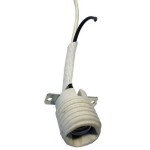Wiring a Ceiling Light: A Comprehensive Guide
Installing a ceiling light is a common DIY task that can enhance your home's ambiance and functionality. Whether you're replacing an existing fixture or adding a new one, understanding the wiring process is crucial. This guide will provide a step-by-step explanation of the essential aspects of wiring a ceiling light, ensuring a safe and efficient installation.
Safety Precautions
Before starting any electrical work, it's essential to prioritize safety. Turn off the power to the circuit you'll be working on at the breaker panel. Use insulated tools and wear safety gloves to prevent electrical shocks. If you're not comfortable working with electricity, consult a qualified electrician.
Materials and Tools
Gather the necessary materials and tools for the job. You'll need:
- New ceiling light fixture
- Electrical wire connectors (wire nuts)
- Screwdriver
- Electrical tape
- Voltage tester
Identifying the Wires
Once you've safely accessed the junction box, you'll see several wires. Identifying them correctly is crucial:
- Ground wire: Green or bare copper wire (connects to the light fixture's green or bare copper grounding screw)
- Neutral wire: White or gray wire (connects to the light fixture's white or silver terminal)
- Hot wire: Black, red, or blue wire (connects to the light fixture's brass or gold terminal)
Connecting the Wires
Now it's time to connect the wires. Twist the ends of the wires together clockwise, ensuring a secure connection. Use wire nuts to cap off each connection, ensuring the wires are securely held and insulated.
- Connect the ground wire from the junction box to the ground wire on the fixture.
- Connect the neutral wire from the junction box to the neutral wire on the fixture.
- Connect the hot wire from the junction box to the hot wire on the fixture.
Double-Checking Connections
Once the wires are connected, double-check your work with a voltage tester. Touch one probe to the light fixture's ground screw and the other to the hot wire. If the tester indicates a voltage, there's a problem. Turn off the power and consult a qualified electrician.
Mounting the Fixture
With the wires securely connected, it's time to mount the light fixture. Align the fixture with the junction box and secure it with the provided screws or brackets.
Testing the Light
Turn on the power at the breaker panel and flip the switch for the ceiling light. If the light turns on without any issues, the installation was successful. If there are any problems, refer to the troubleshooting tips provided by the light fixture manufacturer or contact a qualified electrician.
Additional Tips
- Use electrical tape to insulate any exposed wire ends for added safety.
- If you're installing a dimmer switch, use LEDs or other dimmable bulbs to ensure compatibility.
- If you're replacing a light fixture with a fan, consider hiring an electrician due to the additional wiring involved.

Jim Lawrence Flush Lights Fitting Guide

Extending A Lighting Circuit Step By Guide And

Replacing A Ceiling Fan Light With Regular Fixture Jlc

Inside The Circuit Pendant Lighting Light Switch Wiring Homeowner Faqs

How To Install A Ceiling Light Fixture Diy Family Handyman

How To Replace A Ceiling Fan With Pendant Light

How To Install A Ceiling Light Fixture Diy Family Handyman

How To Hang A Ceiling Light

Mounting Light Fixtures Fine Homebuilding

How To Install A Ceiling Light Fixture Diy Family Handyman
Related Posts








